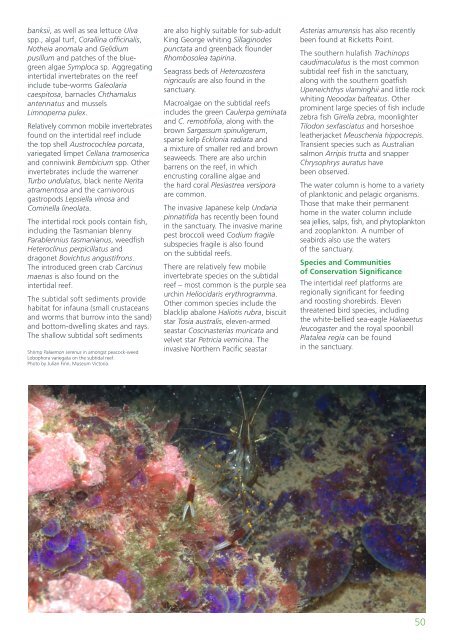Marine Natural Values Study Summary - Parks Victoria
Marine Natural Values Study Summary - Parks Victoria
Marine Natural Values Study Summary - Parks Victoria
Create successful ePaper yourself
Turn your PDF publications into a flip-book with our unique Google optimized e-Paper software.
anksii, as well as sea lettuce Ulvaspp., algal turf, Corallina officinalis,Notheia anomala and Gelidiumpusillum and patches of the bluegreenalgae Symploca sp. Aggregatingintertidal invertebrates on the reefinclude tube-worms Galeolariacaespitosa, barnacles Chthamalusantennatus and musselsLimnoperna pulex.Relatively common mobile invertebratesfound on the intertidal reef includethe top shell Austrocochlea porcata,variegated limpet Cellana tramosericaand conniwink Bembicium spp. Otherinvertebrates include the warrenerTurbo undulatus, black nerite Neritaatramentosa and the carnivorousgastropods Lepsiella vinosa andCominella lineolata.The intertidal rock pools contain fish,including the Tasmanian blennyParablennius tasmanianus, weedfishHeteroclinus perpicillatus anddragonet Bovichtus angustifrons.The introduced green crab Carcinusmaenas is also found on theintertidal reef.The subtidal soft sediments providehabitat for infauna (small crustaceansand worms that burrow into the sand)and bottom-dwelling skates and rays.The shallow subtidal soft sedimentsShrimp Palaemon serenus in amongst peacock-weedLobophora variegata on the subtidal reef.Photo by Julian Finn, Museum <strong>Victoria</strong>.are also highly suitable for sub-adultKing George whiting Sillaginodespunctata and greenback flounderRhombosolea tapirina.Seagrass beds of Heterozosteranigricaulis are also found in thesanctuary.Macroalgae on the subtidal reefsincludes the green Caulerpa geminataand C. remotifolia, along with thebrown Sargassum spinuligerum,sparse kelp Ecklonia radiata anda mixture of smaller red and brownseaweeds. There are also urchinbarrens on the reef, in whichencrusting coralline algae andthe hard coral Plesiastrea versiporaare common.The invasive Japanese kelp Undariapinnatifida has recently been foundin the sanctuary. The invasive marinepest broccoli weed Codium fragilesubspecies fragile is also foundon the subtidal reefs.There are relatively few mobileinvertebrate species on the subtidalreef – most common is the purple seaurchin Heliocidaris erythrogramma.Other common species include theblacklip abalone Haliotis rubra, biscuitstar Tosia australis, eleven-armedseastar Coscinasterias muricata andvelvet star Petricia vernicina. Theinvasive Northern Pacific seastarAsterias amurensis has also recentlybeen found at Ricketts Point.The southern hulafish Trachinopscaudimaculatus is the most commonsubtidal reef fish in the sanctuary,along with the southern goatfishUpeneichthys vlaminghii and little rockwhiting Neoodax balteatus. Otherprominent large species of fish includezebra fish Girella zebra, moonlighterTilodon sexfasciatus and horseshoeleatherjacket Meuschenia hippocrepis.Transient species such as Australiansalmon Arripis trutta and snapperChrysophrys auratus havebeen observed.The water column is home to a varietyof planktonic and pelagic organisms.Those that make their permanenthome in the water column includesea jellies, salps, fish, and phytoplanktonand zooplankton. A number ofseabirds also use the watersof the sanctuary.Species and Communitiesof Conservation SignificanceThe intertidal reef platforms areregionally significant for feedingand roosting shorebirds. Eleventhreatened bird species, includingthe white-bellied sea-eagle Haliaeetusleucogaster and the royal spoonbillPlatalea regia can be foundin the sanctuary.50
















